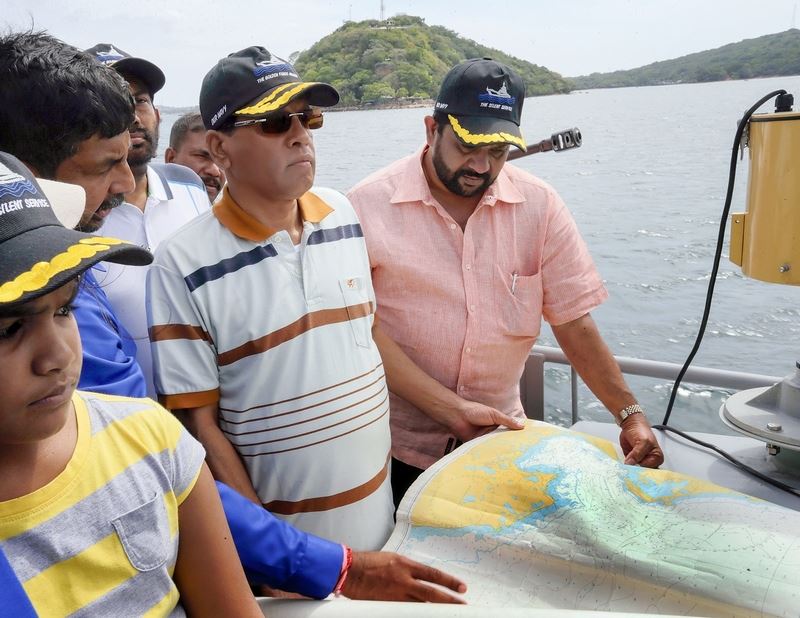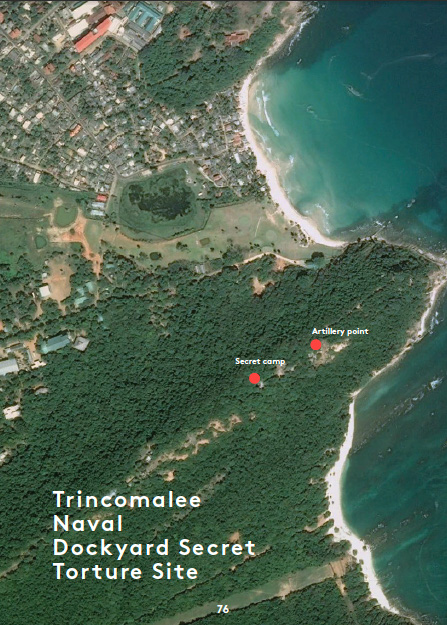
Sri Lanka’s President Maithripala Sirisena on Sunday has visited the Trincomalee naval base, which has been widely and credibly accused to have housed secret torture camps, where hundreds of Tamils have been brutally tortured and raped during and after the war.
According to President’s media unit, President Sirisena has made an “inspection tour” to the Trincomalee Naval base Sunday morning before boarding an Israeli-built Dvora fast attack craft and visiting the museum where the heavy weapons captured by the Navy from the LTTE are kept.
It is not immediately known whether the President, who has publicly promised to look after the interests of all the community including that of the Tamils, has taken any step during his trip to the Naval base to address the long-lasting issue of torture camps there.
The existence of secret torture sites in Sri Lanka has long been alleged by human rights groups and the only response from the successive governments has been to deny it outright.
Exposing shocking details of torture and sexual violence, International Truth & Justice Project (ITJP) last month in a report identified many torture camps and several officers who carried out the systematic persecution of Tamils through torture, rape, illegal detention and killings.
The ITJP said it compiled its latest report – “Still Unfinished War: Sri Lanka’s Survivors of Torture and Sexual Violence 2009-2015″ – based on victims’ accounts and corroborative evidence from the government and military insiders.
The report revealed details of more than 40 torture sites, including the Trincomalee Naval base while naming over 60 rapists and torturers, all of whom are attached to the government security forces.

“The case of the Trincomalee Naval Dockyard is somewhat different, in that the detainees knew where they were being held, but according to their accounts considerable efforts were made to hide their location from their family members, the authorities and other branches and members of the security forces,” the ITJP, administered by transitional justice expert Yasmin Sooka, who was also a member of the UN Expert Panel on Sri Lanka, said in its report.
“This secret torture site run by naval intelligence was hidden in the jungle-covered hills of the Trincomalee Naval Dockyards compound (GPS: 8’33’26’13 N, 81’14’32’87 E). The detention buildings were clustered around an old colonial artillery point. One detention site included small cement cells in an underground bunker and there was another area for holding prisoners above ground,” the report revealed.
(http://www.itjpsl.com/wp-content/uploads/2015/07/Stop-Torture-Report.pdf)
The report said it has additional evidence to say that other LTTE family members were held for years in the main naval compound itself, rather than the secret location.
“Witnesses described being detained in the Naval Dockyard site along with dozens of other people, however said it was possible many more were held in the area that they were not aware of because the site was a large area under the control of naval intelligence and well hidden from outside view. The witnesses interviewed were detained here from the end of the war in 2009 for years,” it said.
Among the 180 cases documented in this report, the ITJP has recorded eight accounts of torture and abuse that happened after January 8, 2015, the most recent being in July 2015.
“In the Trincomalee Naval Dockyard secret site detainees were also told by guards that they were “under Gota’s surveillance”, by which they understood that this site was maintained by officers who reported directly to Gotabaya Rajapaksa, the then Secretary of Defence and President’s brother,” the ITJP report said.
“Witnesses say the naval intelligence officer running the site initially until 2010 was Lt Commander Welagedara. Lt Commander Ranasinghe then took over the running of the site, according to survivors. Lt Commander K C Welagedara has been described in the local media in Sri Lanka as a staff officer of the marine intelligence unit, allegedly involved in human trafficking to Australia, the report said, adding that this officer bearing the number NRX 1583 was awarded in August 2012 a long service medal.
In addition, ITJP said it has the names and ranks of 10 other navy members who were allegedly involved in torture in this site and the details of an officer and other guards present who were fully aware of the torture going on.
Colombo Fort Magistrate’s Court in April this year, imposed an overseas travel ban on former Navy Spokesman, Commander D.K.P. Dassanayake, Lt. Commander Sampath Munasinghe, Ranasinghe Arachchige Hettiarachchi and Ranasinghe Pedige Sumith Ranasinghe for their alleged complicity regarding the disappearances of at least 28 people.
President is on a weekend visit to the Eastern port city. On Saturday, he attended a ceremony to hand over the land deeds to 234 war displaced families in Sampur. During the Rajapaksa regime, people from 818 acre of lands were evicted from these lands by the Navy before being declared as High Security Zone. Some of these lands were given to BOI under a special gazette notification. President Sirisena cancelled this gazette notification in a bid to return it to the original owners.
Mounting pressure on Sri Lanka, a reputable UN-based Charity for torture survivors has urged the international community not to ‘interpret’ the election as “a green light to ignore torture” which it says ongoing despite the regime change at the January 8 presidential poll.
“We hope this creates a climate for a concerted effort by the new government to deliver root and branch reforms after decades of abuses, including the entrenched torture… However the international community should not interpret the election as a green light that all is well on human rights,” the Freedom from Torture said on Tuesday.